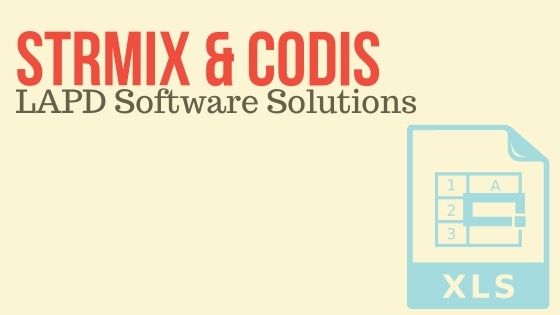With the increasing adoption of probabilistic genotyping software for forensic DNA mixture analysis, the need for methods to upload and perform comparisons for deconvolutions has risen. LAPD has developed internal solutions and methods to develop profiles suitable for CODIS upload from STRmix deconvolution results as well as software tools to aid analysts in comparing possible candidate matches to evidence samples.
STRmix deconvolutions generally are a list of probable genotype sets that can explain a given evidence profile organized by weight. Though the genotype sets are fantastic for considering possible genotypes, it can be difficult to determine how best to generate a CODIS eligible profile from them. LAPD has developed an excel-based program named POPSTR (Probability Optimized Profile) that imports STRmix results files and generates full or partial single source profiles whenever possible. POPSTR generates a single source profile from STRmix deconvolutions, evaluates which genotypes or alleles to use based on weights, automatically calculates MME/MRE for CODIS eligibility, and the software can switch over to generating mixtures when single source profiles cannot be developed.
It can be difficult to determine which sample is best to upload into CODIS for cases with multiple mixture samples, especially when they contain a common contributor. The STRmix deconvolutions for each sample are often different even with a shared contributor and it’s not always obvious where the contributors can line up. Through the FORESTR software, LAPD is able to compare multiple samples and contributors in an easy to read side-by-side view that aids analysts in making an informed choice.
The DATABSR program was created by LAPD in order to rapidly evaluate CODIS hits. LAPD averages around 150 CODIS hits a month and required a tool to help resolve the hits in a timely manner. DATABSR is able to automatically pull the STRmix result files that generated CODIS hits, calculate likelihood ratios for the potential candidates, and create a report of all matches with LRs above a set threshold.
During ISHI 31, Brian Kim demonstrated how LAPD uses excel-based programs to handle STRmix deconvolutions for sample to sample comparisons, generating CODIS eligible profiles, and resolving large numbers of database hits. As there was not time for Brian to answer all of the questions that came in during the conference, we’ve compiled them here. If you have any additional questions about the software options that LAPD has created, please reach out directly to Brian.
Please discuss the impact of required allele designations on the threshold for NDIS
The required allele designation is factored in as part of the MME calculation for NDIS in the exact same way the CODIS software would calculate the MME for an obligate allele. POPSTR actually calculates all MME and MRE calculations exactly the same as POPSTATS.
Are other labs using POPSTR or DATABSR, or is it just used in-house?
Currently, POPSTR and DATABSR are only being used in-house but there are a few other labs evaluating it.
Approximately what percentage of that large increase in matches were actually true hits? When you say hits, I just wanted to clarify if they were in fact hits and not matches (candidate matches)?
We average about 125-150 uploads a month with an average of 300-400 candidate matches a month. Out of those 300-400 candidate matches, we get around 90-110 arrestee/offender hits and approximately 30-50 case to case hits that we would consider true hits. Our true hit rate is around 80-90% of our upload numbers, but this is definitely inflated due to our case to case hits as a single upload can generate multiple true case to case hits. In general, 60-70% of our uploads generate a true hit to a unique arrestee/offender or a case to case hit.
Does PopSTR create a CMF file for upload into CODIS?
POPSTR generates an XML file that can be imported directly into the CODIS software.
Will you be willing to share POPSTR and DATABSR with other laboratories? Is there a cost associated with the software?
We would be glad to share the software with other laboratories. There is no cost associated with the software as it’s just a homebrew software.
What does Jo Bright think of your PopSTR?? 🙂
We haven’t had the chance to hear her thoughts on it yet but would love to know as well!
WOULD YOU LIKE TO SEE MORE ARTICLES LIKE THIS? SUBSCRIBE TO THE ISHI BLOG BELOW!
SUBSCRIBE NOW!


